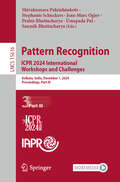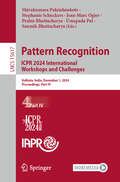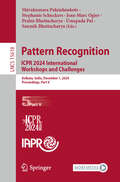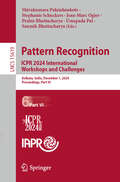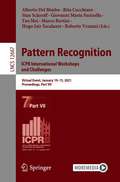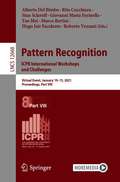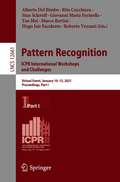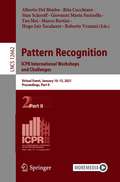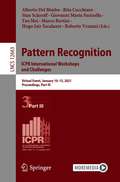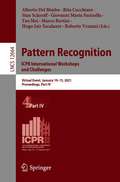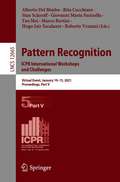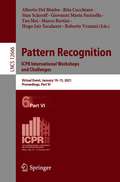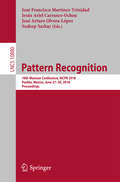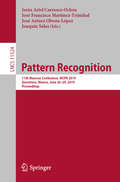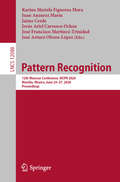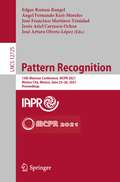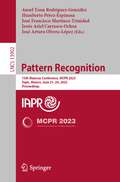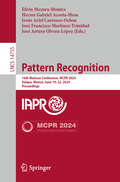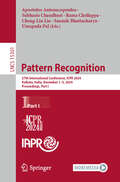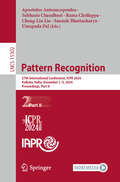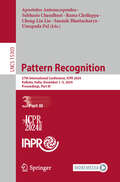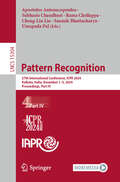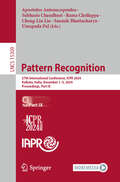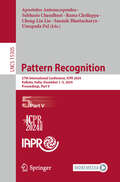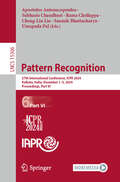- Table View
- List View
Pattern Recognition. ICPR 2024 International Workshops and Challenges: Kolkata, India, December 1, 2024, Proceedings, Part III (Lecture Notes in Computer Science #15616)
by Jean-Marc Ogier Shivakumara Palaiahnakote Umapada Pal Prabir Bhattacharya Saumik Bhattacharya Stephanie SchuckersThis 6-volume set LNCS 15614-15619 constitutes the proceedings of the ICPR 2024 International Workshops and Challenges held under the umbrella of the 27th International Conference on Pattern Recognition, ICPR 2024, which took place in Kolkata, India, during December 1–5, 2024. The 183 full papers presented in these 6 volumes were carefully reviewed and selected from numerous submissions. The 21 ICPR 2024 workshops addressed problems in pattern recognition, artificial intelligence, computer vision, and image and sound analysis, and the contributions reflect the most recent applications related to healthcare, biometrics, ethics, multimodality, cultural heritage, imagery, affective computing, and de-escalation.
Pattern Recognition. ICPR 2024 International Workshops and Challenges: Kolkata, India, December 1, 2024, Proceedings, Part IV (Lecture Notes in Computer Science #15617)
by Jean-Marc Ogier Shivakumara Palaiahnakote Umapada Pal Prabir Bhattacharya Saumik Bhattacharya Stephanie SchuckersThis 6-volume set LNCS 15614-15619 constitutes the proceedings of the ICPR 2024 International Workshops and Challenges held under the umbrella of the 27th International Conference on Pattern Recognition, ICPR 2024, which took place in Kolkata, India, during December 1–5, 2024. The 183 full papers presented in these 6 volumes were carefully reviewed and selected from numerous submissions. The 21 ICPR 2024 workshops addressed problems in pattern recognition, artificial intelligence, computer vision, and image and sound analysis, and the contributions reflect the most recent applications related to healthcare, biometrics, ethics, multimodality, cultural heritage, imagery, affective computing, and de-escalation.
Pattern Recognition. ICPR 2024 International Workshops and Challenges: Kolkata, India, December 1, 2024, Proceedings, Part V (Lecture Notes in Computer Science #15618)
by Jean-Marc Ogier Shivakumara Palaiahnakote Umapada Pal Prabir Bhattacharya Saumik Bhattacharya Stephanie SchuckersThis 6-volume set LNCS 15614-15619 constitutes the proceedings of the ICPR 2024 International Workshops and Challenges held under the umbrella of the 27th International Conference on Pattern Recognition, ICPR 2024, which took place in Kolkata, India, during December 1–5, 2024. The 183 full papers presented in these 6 volumes were carefully reviewed and selected from numerous submissions. The 21 ICPR 2024 workshops addressed problems in pattern recognition, artificial intelligence, computer vision, and image and sound analysis, and the contributions reflect the most recent applications related to healthcare, biometrics, ethics, multimodality, cultural heritage, imagery, affective computing, and de-escalation.
Pattern Recognition. ICPR 2024 International Workshops and Challenges: Kolkata, India, December 1, 2024, Proceedings, Part VI (Lecture Notes in Computer Science #15619)
by Jean-Marc Ogier Shivakumara Palaiahnakote Umapada Pal Prabir Bhattacharya Saumik Bhattacharya Stephanie SchuckersThis 6-volume set LNCS 15614-15619 constitutes the proceedings of the ICPR 2024 International Workshops and Challenges held under the umbrella of the 27th International Conference on Pattern Recognition, ICPR 2024, which took place in Kolkata, India, during December 1–5, 2024. The 183 full papers presented in these 6 volumes were carefully reviewed and selected from numerous submissions. The 21 ICPR 2024 workshops addressed problems in pattern recognition, artificial intelligence, computer vision, and image and sound analysis, and the contributions reflect the most recent applications related to healthcare, biometrics, ethics, multimodality, cultural heritage, imagery, affective computing, and de-escalation.
Pattern Recognition. ICPR International Workshops and Challenges: Virtual Event, January 10-15, 2021, Proceedings, Part VII (Lecture Notes in Computer Science #12667)
by Marco Bertini Giovanni Maria Farinella Hugo Jair Escalante Alberto Del Bimbo Stan Sclaroff Rita Cucchiara Tao Mei Roberto VezzaniThis 8-volumes set constitutes the refereed of the 25th International Conference on Pattern Recognition Workshops, ICPR 2020, held virtually in Milan, Italy and rescheduled to January 10 - 11, 2021 due to Covid-19 pandemic. The 416 full papers presented in these 8 volumes were carefully reviewed and selected from about 700 submissions. The 46 workshops cover a wide range of areas including machine learning, pattern analysis, healthcare, human behavior, environment, surveillance, forensics and biometrics, robotics and egovision, cultural heritage and document analysis, retrieval, and women at ICPR2020.
Pattern Recognition. ICPR International Workshops and Challenges: Virtual Event, January 10-15, 2021, Proceedings, Part VIII (Lecture Notes in Computer Science #12668)
by Marco Bertini Giovanni Maria Farinella Hugo Jair Escalante Alberto Del Bimbo Stan Sclaroff Rita Cucchiara Tao Mei Roberto VezzaniThis 8-volumes set constitutes the refereed of the 25th International Conference on Pattern Recognition Workshops, ICPR 2020, held virtually in Milan, Italy and rescheduled to January 10 - 11, 2021 due to Covid-19 pandemic. The 416 full papers presented in these 8 volumes were carefully reviewed and selected from about 700 submissions. The 46 workshops cover a wide range of areas including machine learning, pattern analysis, healthcare, human behavior, environment, surveillance, forensics and biometrics, robotics and egovision, cultural heritage and document analysis, retrieval, and women at ICPR2020.
Pattern Recognition. ICPR International Workshops and Challenges: Virtual Event, January 10–15, 2021, Proceedings, Part I (Lecture Notes in Computer Science #12661)
by Marco Bertini Giovanni Maria Farinella Hugo Jair Escalante Alberto Del Bimbo Stan Sclaroff Rita Cucchiara Tao Mei Roberto VezzaniThis 8-volumes set constitutes the refereed of the 25th International Conference on Pattern Recognition Workshops, ICPR 2020, held virtually in Milan, Italy and rescheduled to January 10 - 11, 2021 due to Covid-19 pandemic. The 416 full papers presented in these 8 volumes were carefully reviewed and selected from about 700 submissions. The 46 workshops cover a wide range of areas including machine learning, pattern analysis, healthcare, human behavior, environment, surveillance, forensics and biometrics, robotics and egovision, cultural heritage and document analysis, retrieval, and women at ICPR2020.
Pattern Recognition. ICPR International Workshops and Challenges: Virtual Event, January 10–15, 2021, Proceedings, Part II (Lecture Notes in Computer Science #12662)
by Marco Bertini Giovanni Maria Farinella Hugo Jair Escalante Alberto Del Bimbo Stan Sclaroff Rita Cucchiara Tao Mei Roberto VezzaniThis 8-volumes set constitutes the refereed of the 25th International Conference on Pattern Recognition Workshops, ICPR 2020, held virtually in Milan, Italy and rescheduled to January 10 - 11, 2021 due to Covid-19 pandemic. The 416 full papers presented in these 8 volumes were carefully reviewed and selected from about 700 submissions. The 46 workshops cover a wide range of areas including machine learning, pattern analysis, healthcare, human behavior, environment, surveillance, forensics and biometrics, robotics and egovision, cultural heritage and document analysis, retrieval, and women at ICPR2020.
Pattern Recognition. ICPR International Workshops and Challenges: Virtual Event, January 10–15, 2021, Proceedings, Part III (Lecture Notes in Computer Science #12663)
by Marco Bertini Giovanni Maria Farinella Hugo Jair Escalante Alberto Del Bimbo Stan Sclaroff Rita Cucchiara Tao Mei Roberto VezzaniThis 8-volumes set constitutes the refereed of the 25th International Conference on Pattern Recognition Workshops, ICPR 2020, held virtually in Milan, Italy and rescheduled to January 10 - 11, 2021 due to Covid-19 pandemic. The 416 full papers presented in these 8 volumes were carefully reviewed and selected from about 700 submissions. The 46 workshops cover a wide range of areas including machine learning, pattern analysis, healthcare, human behavior, environment, surveillance, forensics and biometrics, robotics and egovision, cultural heritage and document analysis, retrieval, and women at ICPR2020.
Pattern Recognition. ICPR International Workshops and Challenges: Virtual Event, January 10–15, 2021, Proceedings, Part IV (Lecture Notes in Computer Science #12664)
by Marco Bertini Giovanni Maria Farinella Hugo Jair Escalante Alberto Del Bimbo Stan Sclaroff Rita Cucchiara Tao Mei Roberto VezzaniThis 8-volumes set constitutes the refereed of the 25th International Conference on Pattern Recognition Workshops, ICPR 2020, held virtually in Milan, Italy and rescheduled to January 10 - 11, 2021 due to Covid-19 pandemic. The 416 full papers presented in these 8 volumes were carefully reviewed and selected from about 700 submissions. The 46 workshops cover a wide range of areas including machine learning, pattern analysis, healthcare, human behavior, environment, surveillance, forensics and biometrics, robotics and egovision, cultural heritage and document analysis, retrieval, and women at ICPR2020.
Pattern Recognition. ICPR International Workshops and Challenges: Virtual Event, January 10–15, 2021, Proceedings, Part V (Lecture Notes in Computer Science #12665)
by Marco Bertini Giovanni Maria Farinella Hugo Jair Escalante Alberto Del Bimbo Stan Sclaroff Rita Cucchiara Tao Mei Roberto VezzaniThis 8-volumes set constitutes the refereed of the 25th International Conference on Pattern Recognition Workshops, ICPR 2020, held virtually in Milan, Italy and rescheduled to January 10 - 11, 2021 due to Covid-19 pandemic. The 416 full papers presented in these 8 volumes were carefully reviewed and selected from about 700 submissions. The 46 workshops cover a wide range of areas including machine learning, pattern analysis, healthcare, human behavior, environment, surveillance, forensics and biometrics, robotics and egovision, cultural heritage and document analysis, retrieval, and women at ICPR2020.
Pattern Recognition. ICPR International Workshops and Challenges: Virtual Event, January 10–15, 2021, Proceedings, Part VI (Lecture Notes in Computer Science #12666)
by Marco Bertini Giovanni Maria Farinella Hugo Jair Escalante Alberto Del Bimbo Stan Sclaroff Rita Cucchiara Tao Mei Roberto VezzaniThis 8-volumes set constitutes the refereed of the 25th International Conference on Pattern Recognition Workshops, ICPR 2020, held virtually in Milan, Italy and rescheduled to January 10 - 11, 2021 due to Covid-19 pandemic. The 416 full papers presented in these 8 volumes were carefully reviewed and selected from about 700 submissions. The 46 workshops cover a wide range of areas including machine learning, pattern analysis, healthcare, human behavior, environment, surveillance, forensics and biometrics, robotics and egovision, cultural heritage and document analysis, retrieval, and women at ICPR2020.
Pattern Recognition: 10th Mexican Conference, MCPR 2018, Puebla, Mexico, June 27-30, 2018, Proceedings (Lecture Notes in Computer Science #10880)
by Jesús Ariel Carrasco-Ochoa José Francisco Martínez-Trinidad José Arturo Olvera-López Sudeep SarkarThis book constitutes the proceedings of the 10th Mexican Conference on Pattern Recognition, MCPR 2018, held in Puebla, Mexico, in June 2018. The 28 papers presented in this volume were carefully reviewed and selected from 44 submissions. They were organized in topical sections named: pattern recognition principles; deep learning, neural networks and associative memories; data mining; and computer vision.
Pattern Recognition: 11th Mexican Conference, MCPR 2019, Querétaro, Mexico, June 26–29, 2019, Proceedings (Lecture Notes in Computer Science #11524)
by Jesús Ariel Carrasco-Ochoa José Francisco Martínez-Trinidad José Arturo Olvera-López Joaquín SalasThis book constitutes the proceedings of the 11th Mexican Conference on Pattern Recognition, MCPR 2019, held in Querétaro, Mexico, in June 2019. The 40 papers presented in this volume were carefully reviewed and selected from 86 submissions. They were organized in topical sections named: artificial intelligence techniques and recognition; computer vision; industrial and medical applications of pattern recognition; image processing and analysis; pattern recognition techniques; signal processing and analysis; natural language, and processing and recognition.
Pattern Recognition: 12th Mexican Conference, MCPR 2020, Morelia, Mexico, June 24–27, 2020, Proceedings (Lecture Notes in Computer Science #12088)
by Jesús Ariel Carrasco-Ochoa José Francisco Martínez-Trinidad José Arturo Olvera-López Karina Mariela Figueroa Mora Juan Anzurez Marín Jaime CerdaThis book constitutes the proceedings of the 12th Mexican Conference on Pattern Recognition, MCPR 2020, which was due to be held in Morelia, Mexico, in June 2020. The conference was held virtually due to the COVID-19 pandemic.The 31 papers presented in this volume were carefully reviewed and selected from 67 submissions. They were organized in the following topical sections: pattern recognition techniques; image processing and analysis; computer vision; industrial and medical applications of pattern recognition; natural language processing and recognition; artificial intelligence techniques and recognition.
Pattern Recognition: 13th Mexican Conference, MCPR 2021, Mexico City, Mexico, June 23–26, 2021, Proceedings (Lecture Notes in Computer Science #12725)
by Jesús Ariel Carrasco-Ochoa José Francisco Martínez-Trinidad José Arturo Olvera-López Edgar Roman-Rangel Ángel Fernando Kuri-MoralesThis book constitutes the proceedings of the 13th Mexican Conference on Pattern Recognition, MCPR 2021, which was planned to be held in Mexico City, Mexico, in June 2021. The conference was instead held virtually. The 35 papers presented in this volume were carefully reviewed and selected from 75 submissions. They are organized in the following topical sections: artificial intelligence techniques and recognition; pattern recognition techniques; neural networks and deep learning; computer vision; image processing and analysis; and medical applications of pattern recognition.
Pattern Recognition: 15th Mexican Conference, MCPR 2023, Tepic, Mexico, June 21–24, 2023, Proceedings (Lecture Notes in Computer Science #13902)
by Jesús Ariel Carrasco-Ochoa José Francisco Martínez-Trinidad José Arturo Olvera-López Ansel Yoan Rodríguez-González Humberto Pérez-EspinosaThis book constitutes the refereed proceedings of the 15th Mexican Conference on Pattern Recognition, MCPR 2023, held in Tepic, Mexico, during June 21–24, 2023.The 30 full papers presented in this book were carefully reviewed and selected from 61 submissions. The papers are divided into the following topical sections: pattern recognition and machine learning techniques; deep learning and neural networks; medical applications of pattern recognition; language processing and recognition; and industrial applications of pattern recognition.
Pattern Recognition: 16th Mexican Conference, MCPR 2024, Xalapa, Mexico, June 19–22, 2024, Proceedings (Lecture Notes in Computer Science #14755)
by Jesús Ariel Carrasco-Ochoa José Francisco Martínez-Trinidad José Arturo Olvera-López Efrén Mezura-Montes Héctor Gabriel Acosta-MesaThis book constitutes the proceedings of the 16th Mexican Conference on Pattern Recognition, MCPR 2024, held in Xalapa, Mexico, during June 19–22, 2024, Proceedings. The 36 full papers were carefully reviewed and selected from 68 submissions. The papers are organized in subject areas as follows: Pattern Recognition and Machine Learning Techniques; Computer Vision; Medical Applications of Pattern Recognition; Language Processing and Recognition; Deep Learning and Neural Networks.
Pattern Recognition: 27th International Conference, ICPR 2024, Kolkata, India, December 1–5, 2024, Proceedings, Part I (Lecture Notes in Computer Science #15301)
by Rama Chellappa Subhasis Chaudhuri Cheng-Lin Liu Umapada Pal Apostolos Antonacopoulos Saumik BhattacharyaThe multi-volume set of LNCS books with volume numbers 15301-15333 constitutes the refereed proceedings of the 27th International Conference on Pattern Recognition, ICPR 2024, held in Kolkata, India, during December 1–5, 2024. The 963 papers presented in these proceedings were carefully reviewed and selected from a total of 2106 submissions. They deal with topics such as Pattern Recognition; Artificial Intelligence; Machine Learning; Computer Vision; Robot Vision; Machine Vision; Image Processing; Speech Processing; Signal Processing; Video Processing; Biometrics; Human-Computer Interaction (HCI); Document Analysis; Document Recognition; Biomedical Imaging; Bioinformatics.
Pattern Recognition: 27th International Conference, ICPR 2024, Kolkata, India, December 1–5, 2024, Proceedings, Part II (Lecture Notes in Computer Science #15302)
by Rama Chellappa Subhasis Chaudhuri Cheng-Lin Liu Umapada Pal Apostolos Antonacopoulos Saumik BhattacharyaThe multi-volume set of LNCS books with volume numbers 15301-15333 constitutes the refereed proceedings of the 27th International Conference on Pattern Recognition, ICPR 2024, held in Kolkata, India, during December 1–5, 2024. The 963 papers presented in these proceedings were carefully reviewed and selected from a total of 2106 submissions. They deal with topics such as Pattern Recognition; Artificial Intelligence; Machine Learning; Computer Vision; Robot Vision; Machine Vision; Image Processing; Speech Processing; Signal Processing; Video Processing; Biometrics; Human-Computer Interaction (HCI); Document Analysis; Document Recognition; Biomedical Imaging; Bioinformatics.
Pattern Recognition: 27th International Conference, ICPR 2024, Kolkata, India, December 1–5, 2024, Proceedings, Part III (Lecture Notes in Computer Science #15303)
by Rama Chellappa Subhasis Chaudhuri Cheng-Lin Liu Umapada Pal Apostolos Antonacopoulos Saumik BhattacharyaThe multi-volume set of LNCS books with volume numbers 15301-15333 constitutes the refereed proceedings of the 27th International Conference on Pattern Recognition, ICPR 2024, held in Kolkata, India, during December 1–5, 2024. The 963 papers presented in these proceedings were carefully reviewed and selected from a total of 2106 submissions. They deal with topics such as Pattern Recognition; Artificial Intelligence; Machine Learning; Computer Vision; Robot Vision; Machine Vision; Image Processing; Speech Processing; Signal Processing; Video Processing; Biometrics; Human-Computer Interaction (HCI); Document Analysis; Document Recognition; Biomedical Imaging; Bioinformatics.
Pattern Recognition: 27th International Conference, ICPR 2024, Kolkata, India, December 1–5, 2024, Proceedings, Part IV (Lecture Notes in Computer Science #15304)
by Rama Chellappa Subhasis Chaudhuri Cheng-Lin Liu Umapada Pal Apostolos Antonacopoulos Saumik BhattacharyaThe multi-volume set of LNCS books with volume numbers 15301-15333 constitutes the refereed proceedings of the 27th International Conference on Pattern Recognition, ICPR 2024, held in Kolkata, India, during December 1–5, 2024. The 963 papers presented in these proceedings were carefully reviewed and selected from a total of 2106 submissions. They deal with topics such as Pattern Recognition; Artificial Intelligence; Machine Learning; Computer Vision; Robot Vision; Machine Vision; Image Processing; Speech Processing; Signal Processing; Video Processing; Biometrics; Human-Computer Interaction (HCI); Document Analysis; Document Recognition; Biomedical Imaging; Bioinformatics.
Pattern Recognition: 27th International Conference, ICPR 2024, Kolkata, India, December 1–5, 2024, Proceedings, Part IX (Lecture Notes in Computer Science #15309)
by Rama Chellappa Subhasis Chaudhuri Cheng-Lin Liu Umapada Pal Apostolos Antonacopoulos Saumik BhattacharyaThe multi-volume set of LNCS books with volume numbers 15301-15333 constitutes the refereed proceedings of the 27th International Conference on Pattern Recognition, ICPR 2024, held in Kolkata, India, during December 1–5, 2024. The 963 papers presented in these proceedings were carefully reviewed and selected from a total of 2106 submissions. They deal with topics such as Pattern Recognition; Artificial Intelligence; Machine Learning; Computer Vision; Robot Vision; Machine Vision; Image Processing; Speech Processing; Signal Processing; Video Processing; Biometrics; Human-Computer Interaction (HCI); Document Analysis; Document Recognition; Biomedical Imaging; Bioinformatics.
Pattern Recognition: 27th International Conference, ICPR 2024, Kolkata, India, December 1–5, 2024, Proceedings, Part V (Lecture Notes in Computer Science #15305)
by Rama Chellappa Subhasis Chaudhuri Cheng-Lin Liu Umapada Pal Apostolos Antonacopoulos Saumik BhattacharyaThe multi-volume set of LNCS books with volume numbers 15301-15333 constitutes the refereed proceedings of the 27th International Conference on Pattern Recognition, ICPR 2024, held in Kolkata, India, during December 1–5, 2024. The 963 papers presented in these proceedings were carefully reviewed and selected from a total of 2106 submissions. They deal with topics such as Pattern Recognition; Artificial Intelligence; Machine Learning; Computer Vision; Robot Vision; Machine Vision; Image Processing; Speech Processing; Signal Processing; Video Processing; Biometrics; Human-Computer Interaction (HCI); Document Analysis; Document Recognition; Biomedical Imaging; Bioinformatics.
Pattern Recognition: 27th International Conference, ICPR 2024, Kolkata, India, December 1–5, 2024, Proceedings, Part VI (Lecture Notes in Computer Science #15306)
by Rama Chellappa Subhasis Chaudhuri Cheng-Lin Liu Umapada Pal Apostolos Antonacopoulos Saumik BhattacharyaThe multi-volume set of LNCS books with volume numbers 15301-15333 constitutes the refereed proceedings of the 27th International Conference on Pattern Recognition, ICPR 2024, held in Kolkata, India, during December 1–5, 2024. The 963 papers presented in these proceedings were carefully reviewed and selected from a total of 2106 submissions. They deal with topics such as Pattern Recognition; Artificial Intelligence; Machine Learning; Computer Vision; Robot Vision; Machine Vision; Image Processing; Speech Processing; Signal Processing; Video Processing; Biometrics; Human-Computer Interaction (HCI); Document Analysis; Document Recognition; Biomedical Imaging; Bioinformatics.
